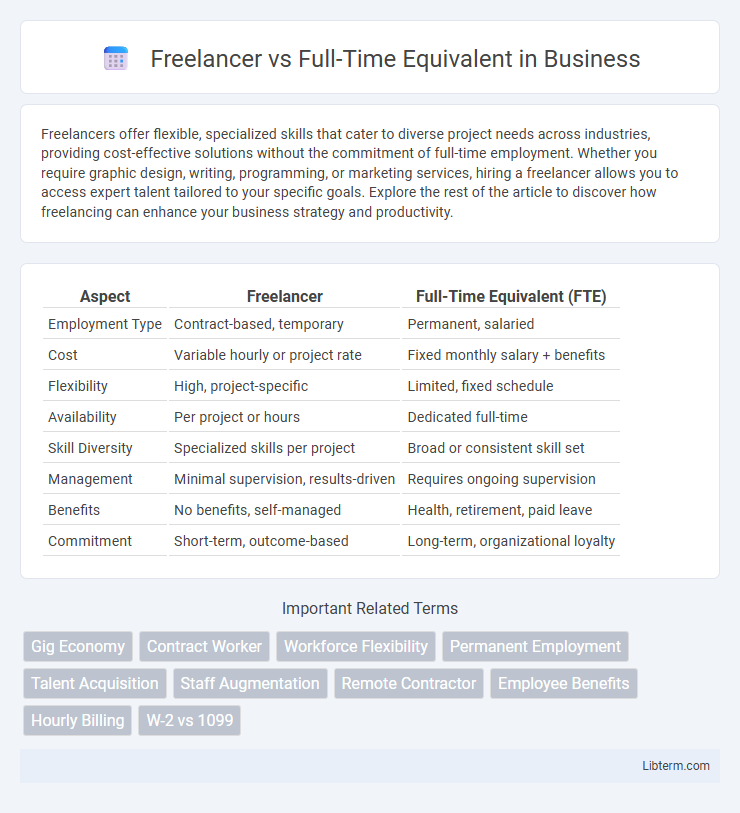Freelancers offer flexible, specialized skills that cater to diverse project needs across industries, providing cost-effective solutions without the commitment of full-time employment. Whether you require graphic design, writing, programming, or marketing services, hiring a freelancer allows you to access expert talent tailored to your specific goals. Explore the rest of the article to discover how freelancing can enhance your business strategy and productivity.
Table of Comparison
| Aspect | Freelancer | Full-Time Equivalent (FTE) |
|---|---|---|
| Employment Type | Contract-based, temporary | Permanent, salaried |
| Cost | Variable hourly or project rate | Fixed monthly salary + benefits |
| Flexibility | High, project-specific | Limited, fixed schedule |
| Availability | Per project or hours | Dedicated full-time |
| Skill Diversity | Specialized skills per project | Broad or consistent skill set |
| Management | Minimal supervision, results-driven | Requires ongoing supervision |
| Benefits | No benefits, self-managed | Health, retirement, paid leave |
| Commitment | Short-term, outcome-based | Long-term, organizational loyalty |
Introduction: Defining Freelancers and Full-Time Equivalents
Freelancers are independent contractors who offer specialized skills on a project or contract basis without long-term employer commitment, providing flexibility to both clients and workers. Full-Time Equivalents (FTEs) represent standard employee units working a defined number of hours per week, typically 40, indicating the total full-time workload within an organization. Understanding these definitions clarifies workforce allocation and budgeting decisions across industries.
Key Differences Between Freelancers and FTEs
Freelancers operate as independent contractors, offering project-based services with flexible schedules, while Full-Time Equivalents (FTEs) are permanent employees with fixed working hours and ongoing responsibilities. Freelancers typically handle multiple clients, bear their own taxes and benefits, whereas FTEs receive company-sponsored benefits, job security, and structured career development opportunities. The cost structure differs as freelancers charge hourly or per project rates, contrasting with FTEs who have fixed salaries and associated employment costs like health insurance and retirement plans.
Hiring Process and Onboarding
The hiring process for freelancers typically involves project-based contracts and quicker vetting through portfolios and short interviews, while full-time equivalent (FTE) employees undergo comprehensive recruitment, background checks, and formal interviews. Onboarding freelancers is streamlined with minimal training focused on project specifics, whereas FTEs receive extensive orientation, integration into company culture, and ongoing development programs. Efficient freelancer onboarding leverages digital tools and remote collaboration, contrasting with structured, multi-phase FTE onboarding designed for long-term alignment and retention.
Cost Comparison: Freelancer vs. FTE
Freelancers typically incur lower upfront costs compared to full-time equivalents (FTEs) due to the absence of benefits, taxes, and long-term commitments, making them cost-effective for short-term projects. FTEs often require a higher total compensation package, including health insurance, retirement benefits, and paid leave, which increases overall expenditure despite potentially lower hourly rates. Cost comparison should factor in project duration, skill requirements, and administrative overhead to determine the most economical choice between freelancers and FTEs.
Flexibility and Scalability
Freelancers offer unparalleled flexibility, allowing businesses to quickly adjust project timelines and resource allocation without long-term commitments. Full-Time Equivalents (FTEs) provide scalability through dedicated availability, ensuring consistent productivity and easier integration within company culture. The choice depends on whether immediate adaptability or steady resource expansion aligns better with organizational goals.
Skill Specialization and Project Suitability
Freelancers offer highly specialized skills tailored to specific project needs, making them ideal for short-term tasks or niche expertise that require flexibility. Full-Time Equivalents (FTEs) provide consistent skill application and deeper company knowledge, ensuring continuity and long-term project alignment. Selecting between freelancers and FTEs depends on the project's complexity, duration, and the required level of skill specialization.
Employment Law and Legal Considerations
Freelancers operate under independent contractor agreements, which differ significantly from full-time equivalents (FTEs) who are covered by employment contracts governed by labor laws, such as minimum wage, benefits, and termination protections. Employment law imposes strict regulations on FTEs related to workplace rights, tax withholding, and social security contributions, while freelancers are responsible for their own tax filings and typically lack employee benefits. Legal considerations also include potential misclassification risks, where treating an FTE as a freelancer can lead to penalties under labor and tax laws, emphasizing the importance of clear contractual terms defining the nature of the working relationship.
Managing Productivity and Accountability
Managing productivity and accountability between freelancers and full-time equivalents (FTEs) requires distinct strategies tailored to their work structures. Freelancers often demand clear deliverables and milestone tracking through project management tools to ensure task completion and quality standards. In contrast, FTEs benefit from ongoing performance reviews and integrated team workflows, fostering continuous engagement and accountability within organizational goals.
Pros and Cons for Businesses
Freelancers offer businesses flexibility and cost savings by providing specialized skills on demand without long-term commitments or employee benefits, reducing overhead expenses. Full-time equivalents ensure consistent availability, team integration, and control over workflows, supporting projects that require ongoing collaboration and institutional knowledge. However, freelancers may face challenges with reliability and continuity, while full-time hires incur fixed costs and potential limitations in adaptability.
How to Choose: Freelancer or Full-Time Employee?
Choosing between a freelancer and a full-time equivalent (FTE) depends on project duration, budget flexibility, and control needs. Freelancers offer specialized skills and cost efficiency for short-term or variable workloads, while FTEs provide stability, consistent availability, and deeper integration with company culture for long-term projects. Evaluate task complexity, required commitment, and internal resource management before deciding on the optimal employment type.
Freelancer Infographic

 libterm.com
libterm.com